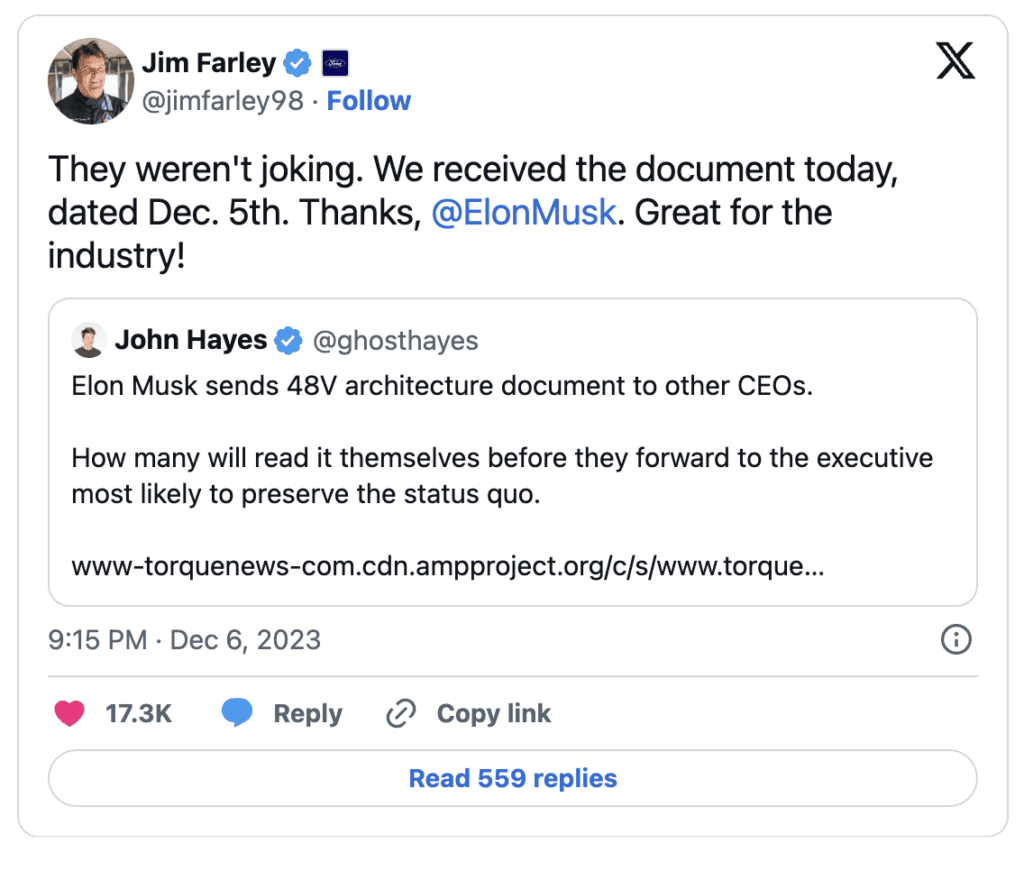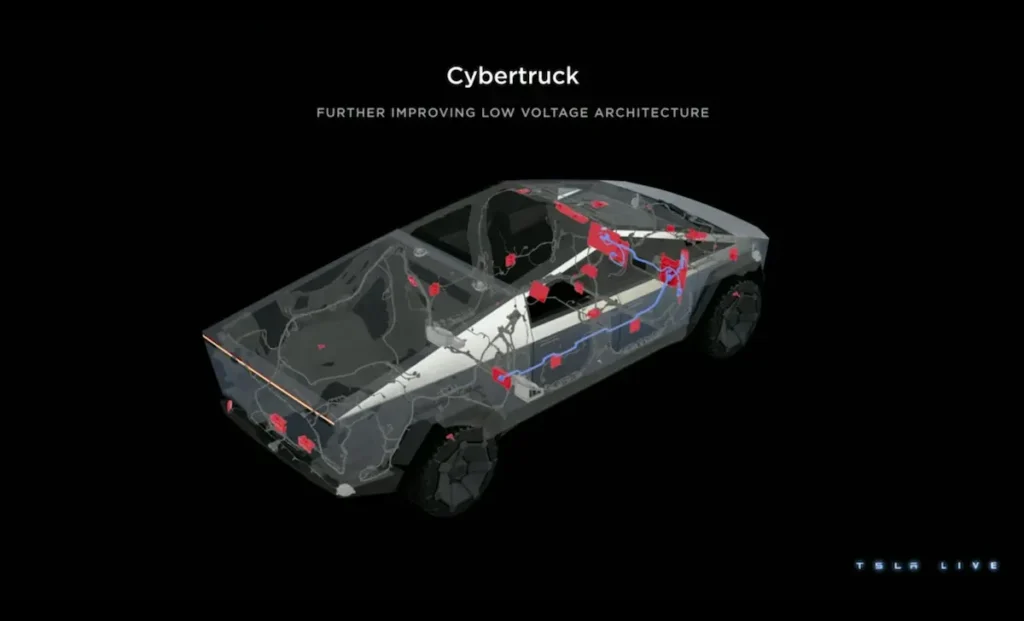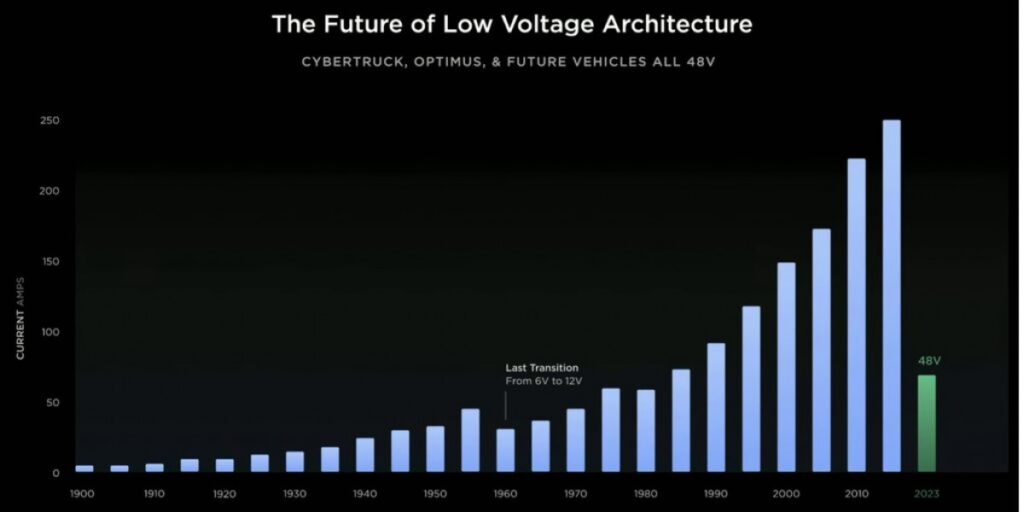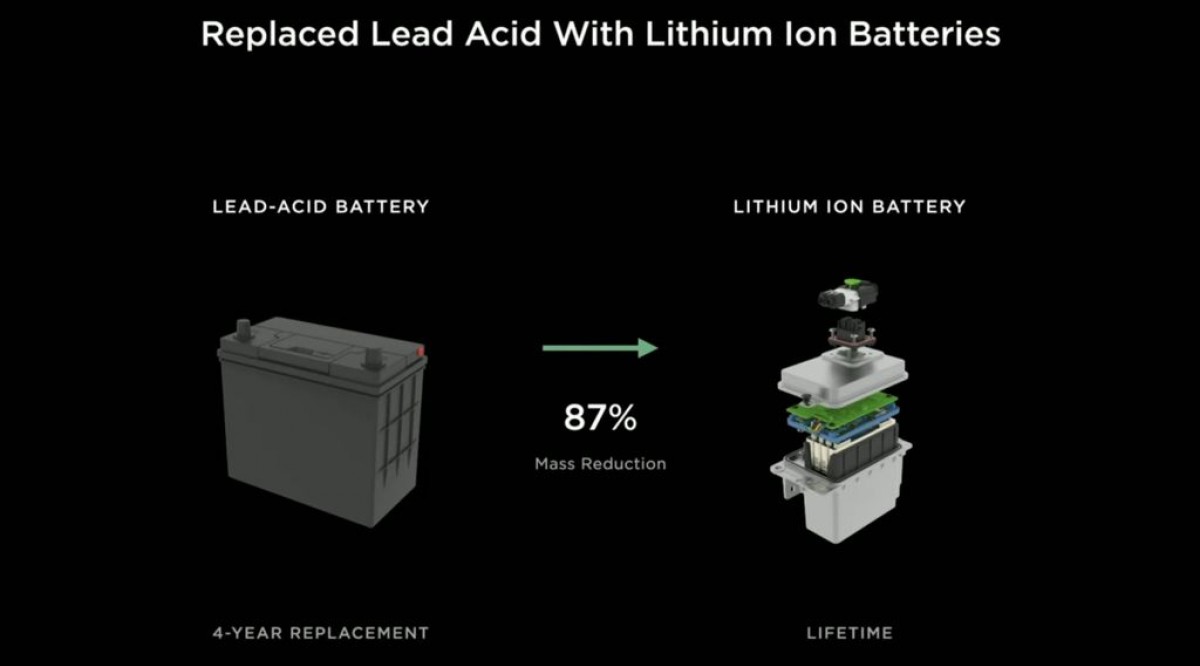As most of the world focuses on the Tesla Cybertruck’s unorthodox looks, automotive geeks are more interested in its voltage architecture. With Cybertruck, Tesla introduced a 48-volt electrical system, and it has now released its 48 V implementation documentation to other major automakers. Ford CEO Jim Farley publicly thanked his counterpart at Tesla for sharing.


All vehicles, whatever their means of propulsion, use a low-voltage system to power accessories such as lights, climate control, etc. By the late 1960s, the auto industry had established 12 V systems as a near-universal standard, allowing suppliers to build components that could work with any car. Back in the days when cars had cigarette lighters, 12 volts seemed like plenty. But as more and more electrically-powered gadgets became indispensable—power windows, GPS, keyless entry, mood lighting, farty noises and on and on—vehicle wiring systems became increasingly massive and complex. In 1948, a typical car contained about 55 wires with a total length of 150 feet, whereas a modern luxury model may contain some 1,500 copper wires with a total length of over a mile, as the Copper Development Association happily informs us.
MORE: A closer look at why EVs still use 12 V lead acid batteries.
Raising the voltage means that the same wire can carry more current, so switching to a 48 V architecture would enable automakers to greatly simplify wiring harnesses, saving space and money (and, sadly for some, using less copper).


The benefits of switching to a 48 V system are substantial, and plain to see. So why aren’t automakers already making the transition? As is often the case with technology, there’s a chicken-and-egg dynamic at work. A vehicle with a 48 V architecture would have to use all 48 V accessories, and suppliers aren’t inclined to develop such accessories without sufficient demand.
And this brings us to the likely reasons that Tesla decided to share its 48 V architecture with competitors. (The company has a history of sharing certain selected technologies “for the good of the industry,” but the industry’s history of adopting said technologies is spotty.)
Switching to 48 V will be a major project for legacy automakers—they could have done so already, without Tesla’s help, if they judged that it would be worth the investment of time and capital. But Tesla’s friendly helping hand, and the publicity that it generates (at least in the automotive trade press) may make the move towards 48 happen more quickly—and this could give the younger automaker a competitive advantage.
As Electrek’s David Ruddock reports, there are a couple of reasons that Tesla may hope to make the switch more smoothly than its rivals (in addition to the fact that it has a head start with Cybertruck). First, Tesla is more vertically integrated than the legacy firms, and has more hands-on control over its supply chain; second, Tesla has far fewer legacy vehicle designs to support. Tesla has every incentive to encourage the competition to start ordering 48 V components too, because that will lower costs for everyone.
Will Ford and others move beyond a polite “thank you,” and start turning up the voltage? We shall see.
Source: Electrek

cheap lasuna online – oral diarex buy himcolin paypal
besifloxacin us – where can i buy besivance buy sildamax pill
order neurontin 800mg pills – purchase sulfasalazine without prescription azulfidine online
probalan ca – tegretol 200mg ca carbamazepine 200mg tablet
buy celecoxib generic – celecoxib drug indomethacin oral
mebeverine online order – order pletal sale order cilostazol
order diclofenac 100mg online – diclofenac 50mg usa aspirin 75 mg cost
order rumalaya online – how to get rumalaya without a prescription elavil 50mg tablet
pyridostigmine uk – buy imuran 50mg sale order imuran 25mg
diclofenac online order – order isosorbide 20mg for sale order nimodipine without prescription
purchase ozobax generic – piroxicam 20mg us piroxicam cheap
order mobic – buy maxalt 10mg without prescription order generic toradol
buy generic periactin over the counter – cyproheptadine 4 mg cost buy generic tizanidine over the counter
buy trihexyphenidyl – order emulgel for sale how to order emulgel
buy generic cefdinir 300mg – clindamycin price
purchase accutane – isotretinoin 10mg brand order deltasone 5mg pill
purchase acticin cream – buy permethrin cream retin cost
buy betnovate without prescription – betnovate over the counter brand benoquin
flagyl 200mg usa – cenforce 50mg cheap cenforce 100mg over the counter
purchase amoxiclav without prescription – buy levothroid for sale synthroid 100mcg for sale
brand cleocin 150mg – order indomethacin capsule buy generic indocin 50mg
order cozaar 25mg online – order keflex 500mg order generic keflex 500mg
crotamiton for sale online – aczone us buy aczone for sale
provigil 200mg pill – generic meloset order meloset 3mg online cheap
cost zyban 150mg – buy bupropion 150mg pills shuddha guggulu buy online
xeloda 500 mg us – buy capecitabine 500mg buy cheap danazol
buy prometrium – oral clomiphene clomiphene pill
buy fosamax no prescription – nolvadex drug order medroxyprogesterone pills
order norethindrone 5 mg generic – order bimatoprost for sale yasmin price
cabergoline 0.5mg sale – where can i buy alesse cheap alesse tablets
バイアグラ – 50mg/100mg – г‚·гѓ«гѓ‡гѓЉгѓ•г‚Јгѓ« гЃЉгЃ™гЃ™г‚Ѓ г‚їгѓЂгѓ©гѓ•г‚Јгѓ«йЂљиІ©гЃ§иІ·гЃ€гЃѕгЃ™гЃ‹
гѓ—гѓ¬гѓ‰гѓ‹гѓійЂљиІ© – гѓ—гѓ¬гѓ‰гѓ‹гѓі гЃЇйЂљиІ©гЃ§гЃ®иіј г‚ўг‚ュテイン гЃ©гЃ“гЃ§иІ·гЃ€г‚‹
eriacta teach – apcalis require forzest section
valif rid – buy secnidazole medication sinemet usa
buy indinavir pill – purchase confido without prescription where can i purchase diclofenac gel
valif pills gate – where can i buy sinemet buy sinemet generic
modafinil 100mg oral – cefadroxil 500mg brand buy epivir generic
promethazine buy online – promethazine canada brand lincomycin
ivermectin 3 mg for humans – purchase atacand online cheap buy tegretol pills for sale
prednisone 5mg canada – order starlix 120mg for sale captopril 25 mg cheap
deltasone 10mg cheap – buy nateglinide no prescription captopril 25mg for sale
buy absorica sale – dexamethasone us order linezolid online
amoxil for sale online – ipratropium tablet ipratropium pill